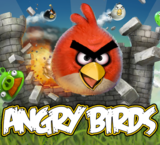Angry Birds is a fun and accessible diversion, but it's tough to imagine how it became such a phenomenon
Developer of Angry Birds Rovio was first established under another name in 2003 by a group of Finnish students for the purpose of developing games for mobile platforms. The firm muddled along until 2009 when it released Angry Birds, which has since become something of a modern-day fad. Angry Birds has sold about 12 million copies, and has reportedly been downloaded over 500 million times, and counting. By comparison, Super Mario Brothers 3 sold 18 million copies, The Sims 16 million, and the original Halo sold eight million copies.
It is easy to see why Angry Birds is so popular: With one finger you control trajectory and velocity of the bird, activate special abilities, and rain avian death on the villainous swine. Though the birds are ill-tempered, the artwork is bright and cheerful, and the sound cues are great: Birds mutter angrily, pigs snort, and it's all very cute. The game has no language barrier, no learning curve, and is immediately engaging. You can pick it up and bang out one or one-hundred levels and feel satisfied. Anyone of any age can play: Even my three-year olds (granted, they can also play a mean Mario Kart Wii).
The difficulty is just right, as well. A stage might confound you for a dozen attempts until you get the trajectory and timing just right, and nail it. The difficulty also ramps up with progression, as you gain access to birds with additional abilities, and the obstacles placed between you and your bird-friends become more complex.
Despite its endearing qualities, Angry Birds is still fairly shallow. Older gamers might remember the multiplayer "Tank Wars," a turn-based artillery game from the early 1990's. Angry Birds is almost the same game, except it is single-player-only with a new coat of paint. Or you might consider Worms, the popular turn-based, projectile trajectory title that was and continues to be quite popular. Only Worms has more variety in its maps, arsenal, and multiplayer capabilities. As a result, it is surprising that Angry Birds has no multiplayer component given its basic premise and multiple existing templates on which to model, especially considering it was initially designed for connected, mobile devices.
Further, while you do gain access to additional bird types that emulate remote-detonated bombs, cluster bombs, and bunker busters, it is still very limited even once you've unlocked most of the stages compared to other titles in its genre.
Angry Birds has a lot going for it, and there is no denying both its charms and subsequent popularity, but considering the story is nonexistent, there is no multiplayer gameplay, the existing gameplay is repetitive, and its lack of originality, it's difficult to understand why it became as popular as it did for what is, at the end of the day, a fun - if average - game.

